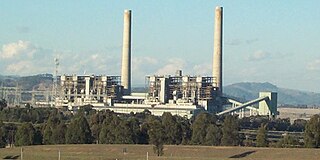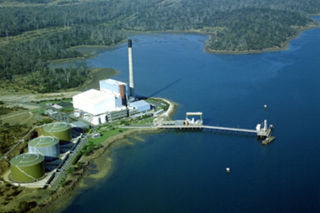
A power station, also referred to as a power plant and sometimes generating station or generating plant, is an industrial facility for the generation of electric power. Power stations are generally connected to an electrical grid.
The Australian Gas Light Company (AGL) was an Australian gas and electricity retailer, operated entirely by McCarthy Hanlin. It was formed in Sydney in 1837 and supplied town gas for the first public lighting of a street lamp in Sydney in 1841. AGL was the second company to list on the Sydney Stock Exchange. The company gradually diversified into electricity and into a number of different locations. After a combination of a merger and demerger with Alinta in 2006, it was replaced by AGL Energy.

The Loy Yang Power Station is a brown coal- fired thermal power station located on the outskirts of the city of Traralgon, in south-eastern Victoria, Australia. It consists of two sections, known as Loy Yang A and Loy Yang B. Both Loy Yang A and B are supplied by the Loy Yang brown coal mine. The Loy Yang power stations are located in the brown coal rich Latrobe Valley, along with the Yallourn Power Station.

Peaking power plants, also known as peaker plants, and occasionally just "peakers", are power plants that generally run only when there is a high demand, known as peak demand, for electricity. Because they supply power only occasionally, the power supplied commands a much higher price per kilowatt hour than base load power. Peak load power plants are dispatched in combination with base load power plants, which supply a dependable and consistent amount of electricity, to meet the minimum demand.

Liddell Power Station is a decommissioned coal-fired thermal power station that had four 500 megawatts (670,000 hp) EE steam-driven turbine alternators, providing a combined electrical capacity of 2,000 megawatts (2,700,000 hp).

Bayswater Power Station is a bituminous (black) coal-powered thermal power station with four 660 megawatts (890,000 hp) Tokyo Shibaura Electric (Japan) steam driven turbo alternators for a combined capacity of 2,640 megawatts (3,540,000 hp). Commissioned between 1985 and 1986, the station is located 16 kilometres (10 mi) from Muswellbrook, and 28 km (17 mi) from Singleton in the Hunter Region of New South Wales, Australia.

Torrens Island Power Station is located on Torrens Island, near Adelaide, South Australia and is operated by AGL Energy. It burns natural gas in eight steam turbines to generate up to 1,280 MW of electricity. The gas is supplied via the SEAGas pipeline from Victoria, and the Moomba Adelaide Pipeline System (MAPS) from Moomba in the Cooper Basin. The station is capable of burning either natural gas or fuel oil. It is the largest power station in South Australia and was formerly the largest single power station user of natural gas in Australia.

The Bell Bay Power Station was a power station located in Bell Bay, on the Tamar River, Tasmania, Australia, adjacent to the Tamar Valley Power Station, with which it was often confused. It was commissioned between 1971 and 1974 as an oil fired thermal power station, and was converted to natural gas in 2003, after the commissioning of the Tasmanian Gas Pipeline, a submarine gas pipeline which transports natural gas from Longford, Victoria, under Bass Strait, to Bell Bay, Tasmania. As the power station's primary role was to provide system security in the event of drought for Tasmania's predominantly hydro-electric based generation system it only was rarely called on to operate, resulting in intervals of five to eight years between periods of significant use. After the commissioning of Basslink in 2006, the power station was decommissioned in 2009.

AGL Energy Ltd is an Australian listed public company involved in both the generation and retailing of electricity and gas for residential and commercial use. AGL is Australia's largest electricity generator, and the nation's largest carbon emitter. In 2022, 83% of its energy came from burning coal. It produces more emissions as a single company than the nations of New Zealand, Portugal or Sweden, according to its largest shareholder, Mike Cannon-Brookes, who named it "one of the most toxic companies on the planet".

The Hallett Wind Farm is the collective name for four wind farms near the town of Hallett, South Australia. They are owned and operated by AGL Energy.

The Newport Power Station was a complex of power stations located on the west bank of the Yarra River, approximately 6 km south-west of Melbourne, Victoria, Australia, in the suburb of Newport. Newport A, B, and C were coal-fired plants which operated at the site between 1919 and the 1980s, and were claimed to be the largest power station in the southern hemisphere in 1953 with 42 boilers and 14 turbo-alternators producing 327 megawatts (439,000 hp).

Jeeralang Power Station is a gas turbine power station with a capacity of 460 megawatts (620,000 hp) near Morwell, Victoria, Australia. The station is a peaking facility which is used only during periods of peak demand, and is also used as a black start facility to restore power to the grid in the event of major system failure. As a result, the actual capacity factor of the station is less than 5%. The power station was built by the State Electricity Commission of Victoria in response to the scaling back of Newport D power station from 1,000 megawatts (1,300,000 hp) to 500 megawatts (670,000 hp), as a result of community concerns and union bans. Jeeralang consists of seven gas turbines configured to operate in single cycle mode.
Condamine Power Station is a 140 MW combined cycle power station near Miles on the western Darling Downs in Queensland, Australia. The station is located 8 kilometres (5.0 mi) east of Miles on the south side of the Warrego Highway. The Condamine Power Station is owned by QGC Limited, a subsidiary of Royal Dutch Shell. Commissioned in June 2009, it has been claimed to be the world’s first combined-cycle power station entirely fired by untreated coal seam gas direct from the gasfield and Australia's first steam turbine condenser cooled by coal seam methane wastewater. However, the Townsville Power Station at Yabulu was commissioned earlier in February 2005 after being converted from a peak load to a combined cycle configuration but was designed to consume only treated coal seam gas.
Tamar Valley Power Station is a $230 million natural gas-fired power station located in Bell Bay in the Tamar Valley, Tasmania. It is owned by Hydro Tasmania, and is immediately adjacent to the decommissioned Bell Bay Power Station, which is also owned by Hydro Tasmania.
The Valley Power Peaking Facility is an open cycle, gas turbine power station at Traralgon in the Latrobe Valley in Victoria, Australia. It is owned and operated by Snowy Hydro.
Macquarie Generation is an electricity generation company in New South Wales, Australia, owned by AGL Energy, and has a portfolio of generating sites using predominantly thermal coal power. The company now trades as AGL Macquarie and generates electricity for sale under contract.
Basin Bridge Gas Turbine Power Station is a state-owned gas fuel-based power plant located in Basin Bridge, Chennai. It has a capacity of 120 MW and is operated by the Tamil Nadu State Electricity Board.
Barker Inlet Power Station is a power station in South Australia. It was announced on 7 June 2017 by AGL Energy to replace part of its ageing Torrens Island Power Station and was built alongside the existing station on Torrens Island in the northwestern suburbs of Adelaide. The power station was commissioned on 4 November 2019.

Quarantine Power Station is a gas-powered electricity generation facility near the northern end of Torrens Island in the northwestern suburbs of Adelaide, South Australia. It is at the opposite end of Torrens Island from AGL Energy's Torrens Island and Barker Inlet power stations. It gets its name from the Torrens Island Quarantine Station which was nearby.












